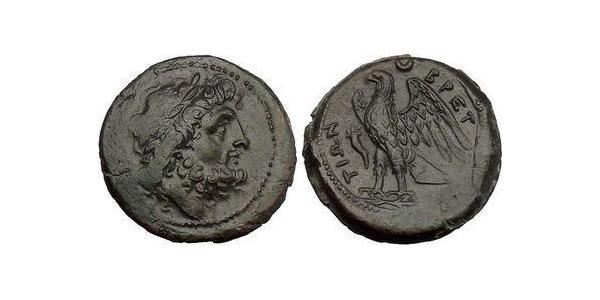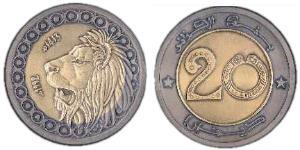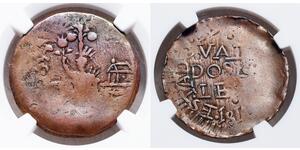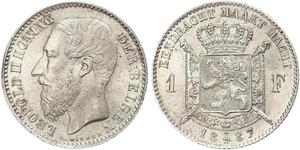[ 5402] Bruttium: The Bretti Bronze (28mm, 10.54 gm.) Bruttium: The Bretti, 211-208 B.C. Reference: HNItaly 1994; SNG Copenhagen 1676; SNG ANS 133. Laureate head of Zeus right at left dagger. BPET-TIΩN, eagle standing left with open wings and head reverted; at left, plough. Provided with certificate of authenticity. CERTIFIED AUTHENTIC by Sergey Nechayev, PhD - Numismatic Expert The Bruttii spoke Oscan, as attested by several finds of Oscan script, though this may have been a later influence from their Sabellic neighbors, the Lucani. Both Greek and Latin writers expressly tell us that Bruttii was the name of the people: no separate designation for the country or province appears to have been adopted by the Romans, who almost universally use the plural form, or name of the nation, to designate the region which they inhabited. Thus Livy uses Consentia in Bruttiis, extremus Italiae angulus Bruttii, Bruttii provincia, etc.: and the same usage prevailed down to a very late period. The name of Bruttium to designate the province or region, though adopted by almost all modern writers on ancient geography appears to be unsupported by any classical authority: Pomponius Mela, indeed, uses in one passage the phrase in Bruttio, but it is probable that this is merely an elliptic expression for in Bruttio agro, the term used by him in another passage, as well as by many other writers. The Greeks, however, used Βρεττία for the name of the country, reserving Βρέττιοι for that of the people. Polybius, in more than one passage, calls it ἡ Βρεττιανὴ Χώρα. The land of the Bruttians, or Bruttium, was bounded on the north by Lucania, from which it was separated by a line drawn from the river Laus near the Tyrrhenian Sea to the Crathis near the Gulf of Tarentum. On the west it was washed by the Tyrrhenian Sea, and on the south and east by that known in ancient times as the Sicilian Sea, including under that appellation the Gulf of Tarentum. All ancient authors agree in stating that neither the name nor the origin of the Bruttians could claim a very remote antiquity. The country occupied by them was inhabited, in the earliest times described by ancient historians, by the Oenotrians – a tribe of Pelasgian origin, of which the Conii and Morgetes appear to have been merely subordinate divisions. It was while the Oenotrians were still masters of the land that the first Greek settlers arrived; and the beauty of the climate and country, as well as the rapid prosperity attained by these first settlements, proved so attractive that within a few years the shores of Bruttium were completely encircled by a belt of Greek colonies, part of Magna Graecia. There are few other informations about the exact relations between these Greek cities and the native Oenotrian tribes, though most likely the latter were reduced to a state of dependence, and at one time at least of complete subjection. The territories of the Greek cities comprised the whole line of coast, so that those of Crotona and Thurii met at the river Hylias, and those of Locri and Rhegium were separated only by the Halex;[5] since both Crotona and Locri founded colonies on the opposite side of the peninsula, most likely the intermediate districts also were at least nominally subject to them. Such appears to have been the state of things at the time of the Peloponnesian War; but in the course of the following century a great change took place. The Sabellian tribe of the Lucanians, who had been gradually extending their conquests towards the south, and had already made themselves masters of the northern parts of Oenotria, now pressed forwards into the Bruttian peninsula, and established their dominion over the interior of that country, reducing its previous inhabitants to a state of vassalage or serfdom. This probably took place after their great victory over the Thurians, near Laus, in 390 BCE; and little more than 30 years elapsed between this event and the rise of the people, properly ...
Mehr...

|
Beigetragen von:
anonymous 2015-08-18 |
Similar Coin Groups

2/3 Thaler Anhalt-Bernburg (1603 - 1863) ...
Diese Gruppe hat 8 Münzen / 7 Preise
Add coin to this group
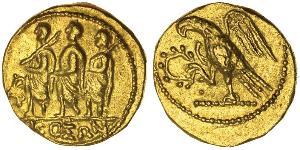
1 Stater Antikes Griechenland (1100BC-33 ...
Diese Gruppe hat 8 Münzen / 8 Preise
Add coin to this group

2 Skilling Dänemark Silber Friedrich VI. ...
Diese Gruppe hat 18 Münzen / 18 Preise
Add coin to this group
2025-05-27
- New coin is added to 1 Franc Belgien Silber Leopold II (1835 - 1909)
1 Franc Belgien Silber Leopold II (1835 - 1909)
Diese Gruppe hat 12 Münzen / 10 Preise
⇑
Belgien, Königreich. Leopold II. 1865-1909. Franc 1887. Flämische Legende. K.M. 29.1. Vorzüglich - Stempelglanz
2025-05-29
- Historical Coin Prices
Das könnte Sie auch interessieren:

